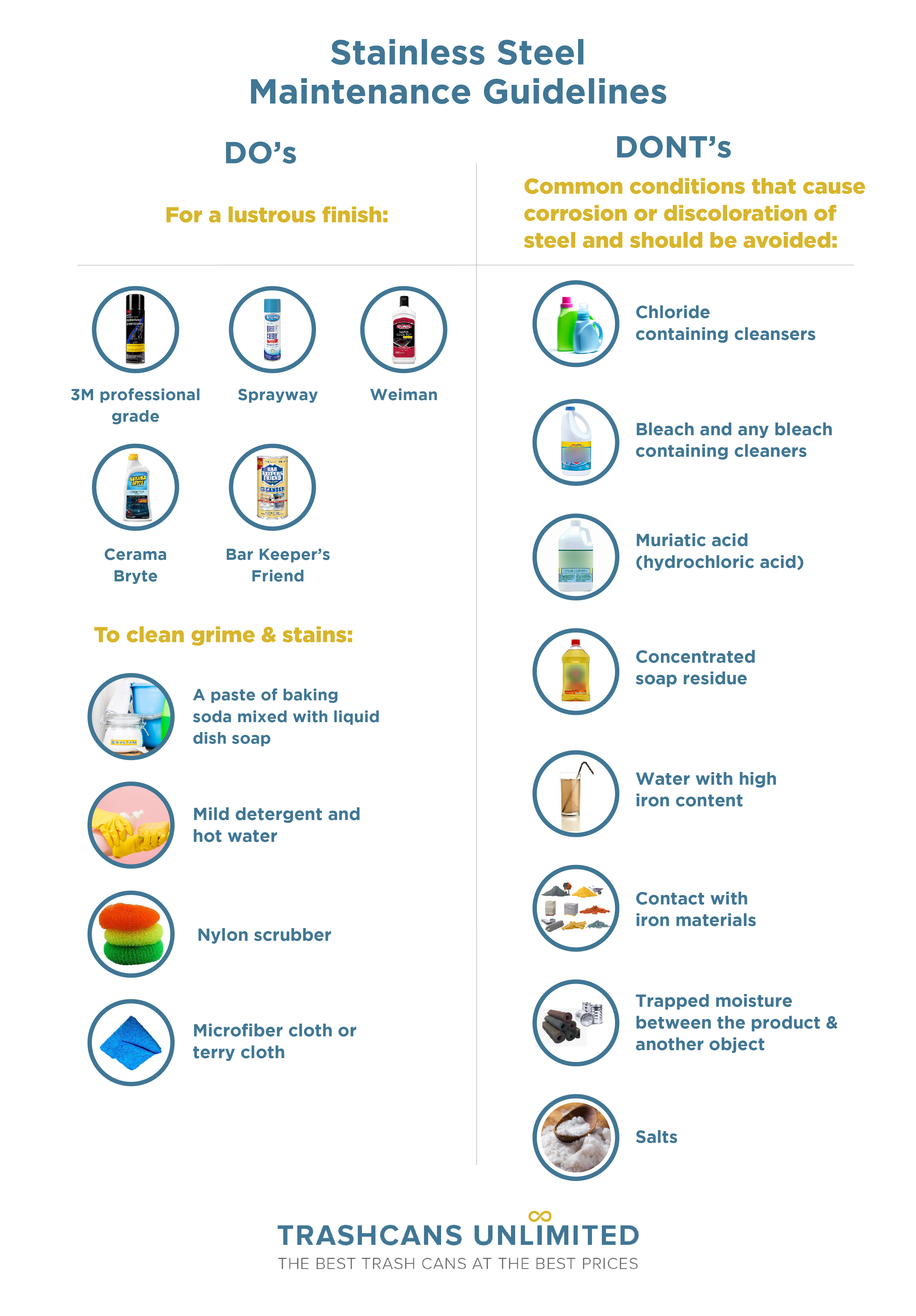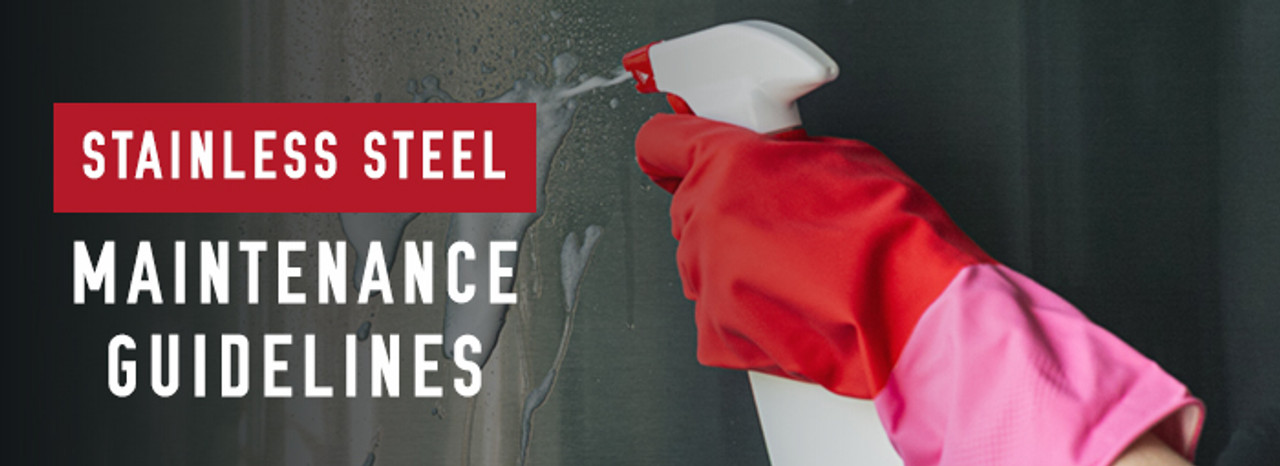If you’re trying to keep stainless steel trash cans clean, there’s some important information to know. It says stainless in the name, but that doesn’t mean it can’t get dirty. Especially in the case of trash cans, making sure that you have a good cleaning regimen and consistently care for your materials will ensure that in the long run, you don’t have to do more serious cleaning activities, such as removing urine smells, maggots, or raccoons.
If your stainless steel trash cans have become damaged beyond repair, Trashcans Unlimited has a huge selection of stainless steel trash cans for offices, stadiums, and more! Keep reading to learn how to keep your stainless steel trash cans clean and shiny.

Do’s & Don’ts of Stainless Steel Maintenance
Stainless steel is not as easy to clean and maintain as you might think, so making sure to follow these key do’s and don’ts will help ensure that you’ve got a nice clean set of garbage cans (or whatever surfaces you’re cleaning).
4 Stainless Steel Maintenance Do’s
1. Clean Stainless Steel Regularly
One of the best habits to adopt is to wipe down your unit on a regular basis with a damp, soapy washcloth. Regularly cleaning your trash cans with a mild detergent will keep them fresh and clean. Make sure they’re dry before you start using them again. Leftover moisture may lead to mold and mildew growth.
- Extra mess can be scrubbed with a scouring pad or scrub brush.
- You can also soak the bottom of the can in warm soapy water for 15 minutes to really make sure everything is clean. Wipe dry with a towel and/or leave in the sun to dry.
- To remove really tough dirt and stains, make a paste of baking soda mixed with liquid dish soap and gently scrub with a nylon scrubbie or an old toothbrush.
- If some stains remain, use undiluted vinegar, again scrubbing gently with a soft brush. Be sure to rinse and towel dry.
Always wipe in the direction of the stainless steel “grain”, starting at the top of the unit and working your way down towards the floor.
Additionally:
- Wipe down spills immediately so that they don’t have time to get sticky and gummy. A dampened microfiber cloth or paper towel is the perfect tool for this.
- If you clean your trash can weekly, sprinkle baking soda in the bottom to neutralize odors. Don’t use baking soda if you go longer between garbage can cleanings because it can clump up and make a bigger mess.
- Every time you change the liner, wipe with a spray of cleanser or solution of 50/50 vinegar and water and wipe it with a towel.
2. Use the Right Tools on Stainless Steel
For heavier dirt and stains, use a nylon scrubbie, a mild detergent, and hot water. Be sure to rinse the surface and towel dry to prevent water spots or staining.
3. Buff Stainless Steel Regularly
You may want to buff your units periodically with a stainless steel polish, lemon oil, or a silicone-based spray to maintain a lustrous finish. Apply the polish in the direction of the grain with a lint-free cloth; buff and dry with another lint-free cloth.
4. Use a Non-Abrasive Cleanser on Stainless Steel
There are numerous non-abrasive cleaners and polishes that are designed specifically for use on stainless steel:
- 3M professional grade
- Bar Keeper’s Friend
- Cerama Bryte
- Sprayway
- Weiman
When in doubt, always test your cleaner on someplace hidden, like the back or sides, before moving on to the front or top.
3 Stainless Steel Maintenance Don’ts
Despite its name, stainless steel can and does stain. So first and foremost, for clean stainless steel surfaces avoid doing the following.
1. Don’t Use Abrasive Tools on Stainless Steel
Steel wool, steel brushes, or highly abrasive scrubbing pads can cause scratches or leave a residue of small particles that may rust.
2. Avoid Using Hard Water on Stainless Steel
Gritty, dirty, or excessively hard water can leave spots or brownish stains.
3. Don’t Use Abrasive Cleansers on Stainless steel
Chlorine bleach or any product containing chloride can stain your stainless steel. Don’t use an oven cleaner or a cleaner that states it’s not for use on stainless steel.
The following is a list of common conditions and substances that cause corrosion or discoloration of steel and should be avoided:
- Chloride-containing cleansers – this includes bleach and any bleach-containing cleaners
- Muriatic acid (hydrochloric acid) – commonly used to clean up after tile/concrete installation
- Concentrated soap residue – chemical additives will cause discoloration and some dried soaps actually look like rust
- Water with high iron content – can leave a rusty residue, especially if allowed to drip continuously
- Contact with iron materials – including steel wool, machining chips, and iron residue/dust from installation or cleaning of other steel products.
- Trapped moisture between the product and another object – rubber mats, metal cans of soaps or cleansers
- Salts – contain chlorides
3 Tips for Maintaining a Clean Stainless Steel Trash Can
In addition to the special care and attention that stainless steel requires, don’t forget the other basic rules for trash can maintenance:
1. Always Use Bags & Liners
This one goes without saying. Unless only dry things, like paper, are being thrown in the can, a trash can liner and trash bag is a must to keep the nasty stuff out. Make sure your bin liner always fits snugly around the edges of your trash can. If it falls inside and you don’t realize it, you’re in for some major trash cleanup. Also, always make sure to carry full trash bags to your outdoor container as soon as you can, rather than packing trash down.
2. Rinse Trash Before You Toss It in the Garbage
It may sound funny to some to clean your refuse before tossing it in the garbage, but it’s an effective way to reduce odors. Don’t throw away foods that are liquid or runny. If you do, contain them in a plastic grocery bag first. The same goes for any moldy or spoiled foods.
3. Keep Garbage Cans Sealed
Keep trash cans sealed tight with a lid for two reasons: to keep them dry and to keep pests out. Wet environments are perfect for mold and other bacterial and fungal growths. Outdoor trash cans are particularly vulnerable to pests, precipitation, and other contaminants, but indoor trash cans need to be kept dry and animal-proof too. Make sure outdoor trash cans are covered at all times — either by an attached lid or overhead shelter — but don't lower your standards for indoor bins.
Get the Right Trash Cans from Trashcans Unlimited
If you’re consistently encountering cleaning issues with your stainless steel trash cans, or any other cans for that matter, it might be time to get some new ones, or ones that are more suited to the job. At Trashcans Unlimited, we offer a huge variety of cans to choose from. Our friendly and helpful staff is available to help you find the product you need, and give you advice on how to maintain it. Get in touch with us today to learn more, or start browsing products now.

